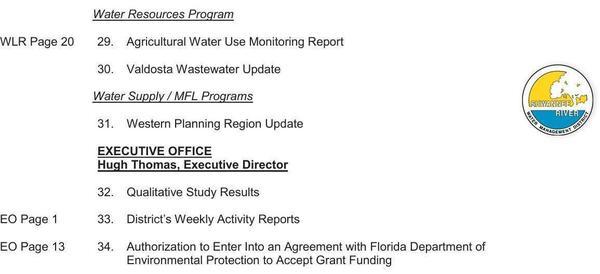It was surprisingly interactive meeting, with the Board members repeatedly questioning staff about multiple projects, sometimes taking up points raised from the audience. One Board Member even stopped a project. Yet half the rump board was not visible, being on the telephone, and the Budget Public Hearing may or may not have been legal.
Nestlé Water Withdrawal Permits
At the rescheduled September SRWMD Board meeting, OSFR President Mike Roth questioned the validity of the permitting process for Nestlé’s proposed 1.2 million gallon per day water withdrawal from Ginnie Springs on the Santa Fe River, since the actual application is from Seven Springs, which proposes to sell the water to Nestlé, which is not a use authorized by Florida Statutes.
I seconded that, and added that the SRWMD Board should revisit Nestlé’s permit for water withdrawal at Madison Blue Springs on the Withlacoochee River, since Florida Statutes to authorize them to do that.
You can comment to SRWMD about Nestlé’s permits.

Photo: Jim Tatum for OSFR, of Suwannee Riverkeeper John S. Quarterman
Afterwards, SRWMD’s Tom Mirti told me the $70,000 contract with SRWMD for Nestlé to support springs water quality monitoring is required by the Nestlé permit for Madison Blue Spring, even though it has to be negotiated separately. Apparently yet another open records request is needed.

![[OSFR President]](https://www.wwals.net/pictures/2019-09-18--srwmd-board-pictures/20190918_152732.jpg)
![[Apparently two have been reappointed]](https://www.wwals.net/pictures/2019-09-18--srwmd-packet/srwmd-reappointed.jpg)
![[Dennis Price explains, 13:50:12, 30.57871, -83.05231]](https://www.wwals.net/pictures/2018-01-27--hike-dead-river-sink/20180127_135013.jpg)
![[Rescinded and Timed Out]](https://www.wwals.net/pictures/2019-09-10--srwmd-packet/srwmd-vacancies.jpg)
![[Location Map]](https://www.wwals.net/pictures/2019-08-13--srwmd-packet/0819-0022.jpg)
![[About SRWMD]](https://www.wwals.net/pictures/2019-06-19--srwmd-paddle-ga/shot0003.jpg)
![[More water quality monitoring]](https://www.wwals.net/pictures/2019-05-31--wwals-fdep-triennial-review/2019-05-30--WWALS-FDEP-Triennial-Review-0001.jpg)

![[Surface water Trend Stations]](https://www.wwals.net/pictures/2019-04-25--srwmd-fl-rivers-task-force-wq-monitoring/20190425-Water-Quality-Monitoring-Final-0005.jpg)

![[Photo: Edwin McCook]](https://www.wwals.net/pictures/2019-05-30--rock-bluff-spring-park/rock-bluff-springs-edwin-mccook.jpg)